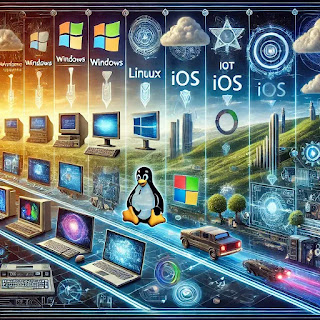Microsoft Windows has undergone significant transformation since its inception, driven by business needs, technological advancements, and competitive pressures. The development of Windows was heavily influenced by the graphical user interface (GUI) innovations introduced by Apple and Xerox, as well as IBM's need for a robust operating system for its personal computers (Brown & Martin, 2021). Microsoft initially developed Windows as a graphical extension of MS-DOS, but as computing demands grew, Windows NT was introduced to provide greater stability and security for enterprise environments (Trower, 2010). Over time, features such as multitasking, networking capabilities, and enhanced user interfaces shaped Windows into the dominant operating system it is today (Gibbs, 2014).
The future of operating systems, including Windows, is being shaped by several key trends. One of the most significant is the integration of cloud computing, which allows for seamless data access and processing across multiple devices. Windows has increasingly embraced cloud-based functionality through services like OneDrive and Windows 365, reducing reliance on local hardware and enabling greater mobility.Another major trend is the Internet of Things (IoT), where interconnected devices communicate and exchange data. Windows is already expanding into IoT applications, providing lightweight versions of its OS for embedded systems and wearable technology. This trend is likely to continue, further integrating Windows into smart homes, industrial automation, and healthcare technologies.
Additionally, augmented reality (AR) and virtual reality (VR) are influencing operating system development. Microsoft's HoloLens demonstrates the company’s commitment to integrating AR with Windows, paving the way for new interfaces and immersive computing experiences. As AR and VR technology advance, Windows may evolve to support more interactive and spatial computing environments, transforming how users interact with digital content.
On the other side of the digital battlefield, Linux remains a formidable contender. Its flexibility, open-source nature, and adaptability have allowed it to dominate server environments, enterprise systems, and emerging AI platforms. As Moody (1997) noted, Linux's open-source model enabled it to grow from a small project into a dominant force in the operating system market. Gilbertson (2007) further emphasized that Linux's transparency and flexibility empowered users to adapt it for countless applications, from supercomputers to embedded systems.
With AI development accelerating, specialized Linux distributions optimized for machine learning could become the norm. Kernel-level optimizations, enhanced GPU driver support, and streamlined AI-specific libraries are likely to define the next wave of Linux innovation. It’s a bit like Starfleet upgrading its warp core — sometimes, the mission demands a whole new level of power and efficiency.
Apple’s iOS also continues to set industry standards with its seamless integration of hardware and software. Johnson (2023) highlights how Apple’s transition from Objective-C to Swift has streamlined app development, fostering greater innovation. Press (2022) further emphasizes how Apple’s dedication to anticipating technological shifts, from Siri to foldable screens, has kept it at the forefront of mobile computing.
Looking ahead, as foldable and rollable screens gain traction, operating systems will face new challenges in delivering adaptive interfaces. Users will expect seamless transitions as devices shift between phone and tablet modes, much like a transforming mech in a sci-fi epic. Companies that prioritize intuitive design and fluid user experiences will undoubtedly lead the charge.
Operating systems are no longer just about managing files and running programs. They’re becoming platforms for AI-powered assistants, immersive experiences, and an interconnected world. Whether it’s Windows, Linux, or iOS, the key to longevity is adaptability. The only constant in the tech world is change, and the future of operating systems will be written by those who embrace it.
References
Brown, S., & Martin, J. (2021, September 3). Microsoft Windows through the years: Version 1.0 to Windows 11. CNET. https://www.cnet.com/pictures/microsoft-windows-through-the-years-version-1-0-to-windows-11/
Gibbs, S. (2014, October 2). From Windows 1 to Windows 10: 29 years of Windows evolution. The Guardian. https://www.theguardian.com/technology/2014/oct/02/from-windows-1-to-windows-10-29-years-of-windows-evolution
Trower, T. (2010, May 8). The secret origin of Windows. Technologizer. https://technologizer.com/2010/03/08/the-secret-origin-of-windows/index.html
Gilbertson, S. (2007, July 30). Linux, the Early Years. Wired. https://www.wired.com/2007/07/linux-the-early-years
Moody, G. (1997, August 1). The greatest OS that (n)ever was. Wired. https://www.wired.com/1997/08/linux-5/
Johnson, A. (2023, October 31). Evolution of IOS app development: From objective-C to swift. Medium. https://medium.com/%40jjohnsonliam1/evolution-of-ios-app-development-from-objective-c-to-swift-7331eb0c39fb
Press, G. (2022, July 1). The day Apple shipped a revolution. Forbes. https://www.forbes.com/sites/gilpress/2022/06/30/the-day-apple-shipped-a-revolution/






